Breaking Boundaries in Wind Engineering: LSU WISE Open-Jet Facility Revolutionizes Solar Panel and Building Design
Abstract
:Featured Application
Abstract
1. Introduction
1.1. Significance and Challenges in Wind Engineering
1.2. Urgency for Advancing Wind Engineering Practices
1.3. Knowledge Gap and Advancements in Wind Engineering
1.4. Paper Layout
2. Challenges in Wall-Bounded Aerodynamic Testing
3. Open-Jet Testing
4. Study 1: Aerodynamics of Low-Rise Buildings: Large-Scale Open-Jet Testing
4.1. Background
4.2. Methods
4.3. Findings
5. Study 2: Resilience of Roof-Mounted Solar Panels to High Wind Loads
5.1. Wind Effects on Roof-Mounted Photovoltaic Panels
5.2. Structural Integrity of Roof-Mounted Solar Panels
5.3. Aerodynamic Testing of Photovoltaic Panels on a Gable-Roofed Building
5.4. Outcomes
6. Study 3: Large-Scale Open-Jet Testing for Cladding Design in High-Rise Buildings
6.1. Objectives of the High-Rise Building Study
6.2. Scale Effects
7. Discussion of Results
7.1. Aerodynamics of Low-Rise Building (Study 1)
7.2. Aerodynamics of a Low-Rise Building with Photovoltaic Panels (Study 2)
7.3. Aerodynamics of High-Rise Buildings (Study 3)
8. Future Research on Solar Energy Systems
8.1. Harmonizing Photovoltaic Panels with Architectural Aesthetics
8.2. Building-Integrated Photovoltaics (BIPV)
9. LSU WISE Open-Jet Testing Vision: Revolutionizing Wind Engineering
9.1. Optimizing Urban Planning and Green Spaces
9.2. Innovations in Architectural Façade Design
9.3. Revolutionizing Offshore Wind Energy
9.4. Advancing Aerospace and Aviation Safety
9.5. Bridging the Gap in Wind–Structure Interaction Research
9.6. Empowering Sustainable Infrastructure Development
9.7. Fostering Interdisciplinary Research Collaborations
10. Conclusions
Funding
Institutional Review Board Statement
Informed Consent Statement
Data Availability Statement
Acknowledgments
Conflicts of Interest
References
- Collins, J.M.; Walsh, K. Hurricanes and Climate Change; Springer: New York, NY, USA, 2017; Volume 3. [Google Scholar] [CrossRef]
- Baptiste, N. Here’s What We Know about Global Warming and Hurricanes. Mother Jones 2017. Available online: https://www.motherjones.com/environment/2017/08/heres-what-we-know-about-global-warming-and-hurricanes/ (accessed on 14 November 2023).
- Al-Chalabi, R.; Elshaer, A. Aerodynamic mitigation of low-rise building with complex roof geometry. Front. Built Environ. 2023, 9, 1200383. [Google Scholar] [CrossRef]
- Knutson, T.R.; McBride, J.L.; Chan, J.; Emanuel, K.; Holland, G.; Landsea, C.; Held, I.; Kossin, J.P.; Srivastava, A.K.; Sugi, M. Tropical cyclones and climate change. Nat. Geosci. 2010, 3, 157–163. [Google Scholar] [CrossRef]
- Mann, M.E.; Emanuel, K.A. Atlantic hurricane trends linked to climate change. Eos Trans. Am. Geophys. Union 2006, 87, 233–241. [Google Scholar] [CrossRef]
- Simiu, E. Design of Buildings for Wind: A Guide for ASCE 7-10 Standard Users and Designers of Special Structures, 2nd ed.; John Wiley & Sons, Inc.: Hoboken, NJ, USA, 2011. [Google Scholar] [CrossRef]
- Guo, D.; Jiang, S.; Zou, Y.; He, X.; Liu, Q. Parametric Study on the Aerodynamic Characteristics of Wind Guide Barriers for a Train–Bridge System. Appl. Sci. 2023, 13, 9058. [Google Scholar] [CrossRef]
- Zhang, Y.; Ke, P.; Hong, P. Aerodynamic Drag Reduction Analysis of Race Walking Formations Based on CFD Numerical Simulations and Wind Tunnel Experiments. Appl. Sci. 2023, 13, 10604. [Google Scholar] [CrossRef]
- Yao, G.; Chen, Y.; Yang, Y.; Zheng, Y.; Wu, L.; Du, H. Research on Mechanism of Vortex-Induced Vibration Railing Effect of Double-Deck Large-Span Suspension Bridge. Appl. Sci. 2023, 13, 9314. [Google Scholar] [CrossRef]
- Holmes, J.D. Wind Loading of Structures, 3rd ed.; CRC Press: London, UK, 2015. [Google Scholar]
- Chen, X.; Zhou, N. Equivalent static wind loads on low-rise buildings based on full-scale pressure measurements. Eng. Struct. 2007, 29, 2563–2575. [Google Scholar] [CrossRef]
- Blessing, C.; Chowdhury, A.G.; Lin, J.; Huang, P. Full-scale validation of vortex suppression techniques for mitigation of roof uplift. Eng. Struct. 2009, 31, 2936–2946. [Google Scholar] [CrossRef]
- Khanduri, A.C.; Stathopoulos, T.; Bédard, C. Wind-induced interference effects on buildings—A review of the state-of-the-art. Eng. Struct. 1998, 20, 617–630. [Google Scholar] [CrossRef]
- Aly, A.M.; Bitsuamlak, G.T.; Chowdhury, A.G. Full-scale aerodynamic testing of a loose concrete roof paver system. Eng. Struct. 2012, 44, 260–270. [Google Scholar] [CrossRef]
- Kareem, A. Wind induced torsional loads on structures. Eng. Struct. 1981, 3, 85–86. [Google Scholar] [CrossRef]
- Ricci, M.; Patruno, L.; de Miranda, S. Wind loads and structural response: Benchmarking LES on a low-rise building. Eng. Struct. 2017, 144, 26–42. [Google Scholar] [CrossRef]
- Belloli, M.; Rosa, L.; Zasso, A. Wind loads on a high slender tower: Numerical and experimental comparison. Eng. Struct. 2014, 68, 24–32. [Google Scholar] [CrossRef]
- Poitevin, A.; Natalini, B.; Godoy, L.A. Pressures on open canopy structures with parapets under wind loading. Eng. Struct. 2013, 56, 850–867. [Google Scholar] [CrossRef]
- He, J.; Pan, F.; Cai, C. A review of wood-frame low-rise building performance study under hurricane winds. Eng. Struct. 2017, 141, 512–529. [Google Scholar] [CrossRef]
- Stathopoulos, T. Wind loads on low-rise buildings: A review of the state of the art. Eng. Struct. 1984, 6, 119–135. [Google Scholar] [CrossRef]
- FEMA. Summary Report on Building Performance: Hurricane Katrina 2005; FEMA: Washington, DC, USA, 2006. [Google Scholar]
- FEMA. Hurricane Sandy in New Jersey and New York; FEMA: Washington, DC, USA, 2013. Available online: https://www.fema.gov/media-library-data/1386850803857-025eb299df32c6782fdcbb6f69b35b13/Combined_Sandy_MAT_Report_508post.pdf (accessed on 14 November 2023).
- Aboulnaga, M.M. High-Rise Buildings in Context of Sustainability; Urban Metaphors of Greater Cairo, Egypt: A Case Study on Sustainability and Strategic Environmental Assessment. In Sustainable High Rise Buildings in Urban Zones; Sayigh, A., Ed.; Springer: Berlin/Heidelberg, Germany, 2017; pp. 163–217. [Google Scholar] [CrossRef]
- Taha, A.E. Vibration Control of a Tall Benchmark Building under Wind and Earthquake Excitation. Pract. Period. Struct. Des. Constr. 2021, 26, 4021005. [Google Scholar] [CrossRef]
- Mendis, P.; Ngo, T.; Haritos, N.; Hira, A.; Samali, B.; Cheung, J. Wind loading on tall buildings. Electron. J. Struct. Eng. 2007, 3, 41–54. [Google Scholar] [CrossRef]
- Tieleman, H.W. Wind tunnel simulation of wind loading on low-rise structures: A review. J. Wind Eng. Ind. Aerodyn. 2003, 91, 1627–1649. [Google Scholar] [CrossRef]
- Aly, A.M.; Khaled, F.; Gol-Zaroudi, H. Aerodynamics of Low-Rise Buildings: Challenges and Recent Advances in Experimental and Computational Methods. In Aerodynamics; IntechOpen: London, UK, 2020; pp. 1–22. [Google Scholar] [CrossRef]
- National Research Council. Review of the Need for a Large-Scale Test Facility for Research on the Effects of Extreme Winds on Structures; The National Academies Press: Washington, DC, USA, 1999. [Google Scholar]
- NOAA Office for Coastal Management. Hurricane Costs. 2021. Available online: https://coast.noaa.gov/states/fast-facts/hurricane-costs.html (accessed on 11 May 2021).
- NHC Public Affair. Costliest U.S. Tropical Cyclones Tables Updated. 2018. Available online: https://www.nhc.noaa.gov/news/UpdatedCostliest.pdf (accessed on 14 November 2023).
- Blake, E.S.; Zelinsky, D.A. National Hurricane Center Tropical Cyclone Report: Hurricane Harvey. 2018. Available online: https://www.nhc.noaa.gov/data/tcr/AL092017_Harvey.pdf (accessed on 14 November 2023).
- Cangialosi, J.P.; Latto, A.S.; Berg, R. National Hurricane Center Tropical Cyclone Report: Hurricane Irma. 2018. Available online: https://www.nhc.noaa.gov/data/tcr/AL112017_Irma.pdf (accessed on 14 November 2023).
- Discher, E. Hurricane Laura blows windows out of 22-story tower in Lake Charles. The Advocate. 2020. Available online: https://www.theadvocate.com/baton_rouge/news/weather_traffic/watch-hurricane-laura-blows-windows-out-of-22-story-tower-in-lake-charles-like-swiss/article_e70053b8-e85f-11ea-bbd8-9b5bdabf8207.html (accessed on 14 November 2023).
- Aly, A.M.; Whipple, J. Wind Forces on Ground-Mounted Photovoltaic Solar Systems: A Comparative Study. Appl. Sol. Energy 2021, 57, 444–471. [Google Scholar] [CrossRef]
- Hoxey, R.P.; Robertson, A.P.; Richardson, G.M.; Short, J.L. Correction of wind-tunnel pressure coefficients for Reynolds number effect. J. Wind Eng. Ind. Aerodyn. 1997, 69–71, 547–555. [Google Scholar] [CrossRef]
- Hoxey, R.P.; Reynolds, A.M.; Richardson, G.M.; Robertson, A.P.; Short, J.L. Observations of Reynolds number sensitivity in the separated flow region on a bluff body. J. Wind Eng. Ind. Aerodyn. 1998, 73, 231–249. [Google Scholar] [CrossRef]
- Richards, P.J.; Hoxey, R.P. Flow reattachment on the roof of a 6 m cube. J. Wind Eng. Ind. Aerodyn. 2006, 94, 77–99. [Google Scholar] [CrossRef]
- Huang, P.; Wang, X.; Gu, M. Field experiments for wind loads on a low-rise building with adjustable pitch. Int. J. Distrib. Sens. Netw. 2012, 2012, 451879. [Google Scholar] [CrossRef]
- ASCE7-2010. Minimum Design Loads for Buildings and Other Structures, ASCE Standard, ASCE/SEI 7-10. American Society of Civil Engineers: Reston, VA, USA, 2010.
- Augustyn, M.; Barski, M.; Chwał, M.; Stawiarski, A. Experimental and Numerical Estimation of the Aerodynamic Forces Induced by the Wind Acting on a Fast-Erecting Crane. Appl. Sci. 2023, 13, 10826. [Google Scholar] [CrossRef]
- Jin, L.; Deng, X.B.; Wang, X.; Zhang, J.; Zeng, W. Review of Mechanisms and Suppression Methods for Low-Frequency Pressure Fluctuations in Open-Jet Wind Tunnels. Appl. Sci. 2023, 13, 10808. [Google Scholar] [CrossRef]
- Aly, A.M.; da Fonseca Yousef, N. High Reynolds number aerodynamic testing of a roof with parapet. Eng. Struct. 2021, 234, 112006. [Google Scholar] [CrossRef]
- ASCE 49-12. Wind Tunnel Testing for Buildings and Other Structures. American Society of Civil Engineers: Reston, VA, USA, 2012. [CrossRef]
- Aly, A.M. Atmospheric boundary-layer simulation for the built environment: Past, present and future. Build. Environ. 2014, 75, 206–221. [Google Scholar] [CrossRef]
- Gol-Zaroudi, H.; Aly, A.M. Open-jet boundary-layer processes for aerodynamic testing of low-rise buildings. Wind Struct. 2017, 25, 233–259. [Google Scholar] [CrossRef]
- Aly, A.M. On the evaluation of wind loads on solar panels: The scale issue. Sol. Energy 2016, 135, 423–434. [Google Scholar] [CrossRef]
- Jafari, A.; Ghanadi, F.; Emes, M.J.; Arjomandi, M.; Cazzolato, B.S. Measurement of unsteady wind loads in a wind tunnel: Scaling of turbulence spectra. J. Wind Eng. Ind. Aerodyn. 2019, 193, 103955. [Google Scholar] [CrossRef]
- Holmes, J.D.; Sankaran, R.; Kwok, K.C.S.; Syme, M.J. Eigenvector modes of fluctuating pressures on low-rise building models. J. Wind Eng. Ind. Aerodyn. 1997, 69–71, 697–707. [Google Scholar] [CrossRef]
- Richards, P.J.; Hoxey, R.; Connell, B.D.; Lander, D.P. Wind-tunnel modelling of the Silsoe Cube. J. Wind Eng. Ind. Aerodyn. 2007, 95, 1384–1399. [Google Scholar] [CrossRef]
- Azzi, Z.; Habte, F.; Elawady, A.; Gan Chowdhury, A.; Moravej, M. Aerodynamic Mitigation of Wind Uplift on Low-Rise Building Roof Using Large-Scale Testing. Front. Built Environ. 2020, 5, 149. [Google Scholar] [CrossRef]
- Asghari Mooneghi, M.; Irwin, P.; Gan Chowdhury, A. Partial turbulence simulation method for predicting peak wind loads on small structures and building appurtenances. J. Wind Eng. Ind. Aerodyn. 2016, 157, 47–62. [Google Scholar] [CrossRef]
- Simiu, E. Toward a Standard on the Wind Tunnel Method. NIST Tech. Note Number 1655. 2009; 51p. Available online: https://www.itl.nist.gov/div898/winds/pdf_files/NISTTN1655.pdf (accessed on 14 November 2023).
- Ho, T.C.E.; Surry, D.; Morrish, D.; Kopp, G.A. The UWO contribution to the NIST aerodynamic database for wind loads on low buildings: Part 1. Archiving format and basic aerodynamic data. J. Wind Eng. Ind. Aerodyn. 2005, 93, 1–30. [Google Scholar] [CrossRef]
- Sagaut, P.; Deck, S.; Terracol, M. Multiscale and Multiresolution Approaches in Turbulence, 2nd ed.; World Scientific: London, UK, 2013. [Google Scholar] [CrossRef]
- Duthinh, D.; Simiu, E. The use of wind tunnel measurements in building design. Wind Tunnels Exp. Fluid Dyn. Res. 2011, 282–300. [Google Scholar] [CrossRef]
- Khaled, M.F.; Aly, A.M. Assessing aerodynamic loads on low-rise buildings considering Reynolds number and turbulence effects: A review. Adv. Aerodyn. 2022, 4, 1–33. [Google Scholar] [CrossRef]
- Aly, A.M.; Chapain, S. Large-Scale Open-Jet Testing for Cladding Design in High-Rise Buildings: Higher Peak Pressures Compared to Wind Tunnels. Pract. Period. Struct. Des. Constr. ASCE 2022, 27, 04022016. [Google Scholar] [CrossRef]
- Aly, A.M.; Rone, E. Wind loads on a low-rise gable roof with and without solar panels and comparison to design standards. Sustain. Resilient Infrastruct. 2023. [Google Scholar] [CrossRef]
- Azzi, Z.; Matus, M.; Elawady, A.; Zisis, I.; Irwin, P.; Gan Chowdhury, A. Aeroelastic Testing of Span-Wire Traffic Signal Systems. Front. Built Environ. 2020, 6, 111. [Google Scholar] [CrossRef]
- Aly, A.M.; Gol-Zaroudi, H. Atmospheric boundary layer simulation in a new open-jet facility at LSU: CFD and experimental investigations. Measurement 2017, 110, 121–133. [Google Scholar] [CrossRef]
- Lundström, D.; Krus, P. Testing of atmospheric turbulence effects on the performance of micro air vehicles. Int. J. Micro Air Veh. 2012, 4, 133–149. [Google Scholar] [CrossRef]
- Aly, A.M.; Chokwitthaya, C.; Poche, R. Retrofitting building roofs with aerodynamic features and solar panels to reduce hurricane damage and enhance eco-friendly energy production. Sustain. Cities Soc. 2017, 35, 581–593. [Google Scholar] [CrossRef]
- Aly, A.M.; Khaled, M.F.; Clancy, R. Large-Scale Open-Jet Testing: A new frontier in structural wind Engineering. Eng. Struct. 2022, 266, 114567. [Google Scholar] [CrossRef]
- Aly, A.M.; Voyiadjis, G.; Twilley, R. Hurricane Flow Generation at High Reynolds Number for Testing Energy and Coastal Infrastructure. In Louisiana Board of Regents; EPSCoR Enhencement, Award no. LEQSF(2016-17)-ENH-TR-03; Louisiana Board of Regents: Baton Rouge, LA, USA, 2016. [Google Scholar]
- SEIA. Solar Market Insight Report 2021 Q3. 2021. Available online: https://www.seia.org/research-resources/solar-market-insight-report-2021-q3 (accessed on 14 November 2023).
- FEMA. Mitigation Assessment Team Report Hurricanes Irma and Maria in Puerto Rico. 2018. Available online: https://www.fema.gov/sites/default/files/2020-07/mat-report_hurricane-irma-maria_virgin-islands.pdf (accessed on 14 November 2023).
- Gill, A.; Genikomsou, A.S. Reconnaissance of Buildings Impacted by the 2018 Tornadoes in Ottawa, Canada. J. Perform. Constr. Facil. 2020, 34, 04020074. [Google Scholar] [CrossRef]
- US Department of Energy. Solar Photovoltaic Systems in Hurricanes and Other Severe Weather. 2018. Available online: https://betterbuildingssolutioncenter.energy.gov/sites/default/files/pv_severe_weather.pdf (accessed on 14 November 2023).
- Simsir, C.C.; Jain, A. Wind-Induced Damage to Rooftop Solar Arrays and Roofs. In Proceedings of the Forensic Engineering 2018: Forgoing Forensic Frontiers, Austin, TX, USA, 29 November–2 December 2018; pp. 53–61. [Google Scholar]
- Henderson, C.; Huff, T.; Bouton, G. Structural Observations and Tornado Damage Mitigation Concepts: March 2020 Tennessee Tornadoes. Pract. Period. Struct. Des. Constr. 2021, 26, 05021001. [Google Scholar] [CrossRef]
- Burgess, C.; Detweiler, S.; Needham, C.; Oudheusden, F. Solar Under Storm Part II: Select Best Practices for Resilient Roof-Mount PV Systems with Hurricane Exposure, Clinton Foundation, FCX Solar, and Rocky Mountain Institute. 2020. Available online: https://nowsolar.files.wordpress.com/2020/05/solar_under_storm_part_two.pdf (accessed on 14 November 2023).
- UNIRAC. Solarmount Detail Drawings 2017. pp. 1–17. Available online: https://ressupply.com/documents/unirac/SolarMount_Detail_Drawings.pdf (accessed on 14 November 2023).
- ASCE/SEI 7-16. Minimum Design Loads and Associated Criteria for Buildings and Other Structures. American Society of Civil Engineers: Reston, VA, USA, 2017; ISBN 9780784414248.
- ASCE/SEI 7-22. ASCE Minimum Design Loads and Associated Criteria for Buildings and Other Structures. American Society of Civil Engineers: Reston, VA, USA, 2022; Electronic Version. Available online: https://ascelibrary.org/doi/book/10.1061/9780784415788 (accessed on 14 November 2023).
- Abdelwahab, M.; Ghazal, T.; Nadeem, K.; Aboshosha, H.; Elshaer, A. Performance-based wind design for tall buildings: Review and comparative study. J. Build. Eng. 2023, 68, 106103. [Google Scholar] [CrossRef]
- Ronca, P.; Crespi, P.G.; Longarini, N.; Zucca, M.; Zichi, A. Structural analysis for an historical RC tall building restoration. In Proceedings of the Rehabend 2016-Construction Pathology, Rehabilitation Technology and Heritage Management, Burgos, Spain, 24–27 May 2016; pp. 960–967. [Google Scholar]
- Porada, B. The Timber Tower Research Project: Re-Imagining the Skyscraper. 2013. Available online: https://www.archdaily.com/384032/the-timber-tower-research-project-re-imagining-the-skyscraper (accessed on 14 November 2023).
- Samali, B.; Kwok, K.C.S.; Wood, G.S.; Yang, J.N. Wind Tunnel Tests for Wind-Excited Benchmark Building. J. Eng. Mech. 2004, 130, 447–450. [Google Scholar] [CrossRef]
- Cheng, X.; Huang, G.; Yang, Q.; Zhou, X. Influence of Architectural Facades on Wind Pressures and Aerodynamic Forces of Tall Buildings. J. Struct. Eng. 2021, 147, 04020303. [Google Scholar] [CrossRef]
- Sadek, F.; Simiu, E. Peak Non-Gaussian Wind Effects for Database-Assisted Low-Rise Building Design. J. Eng. Mech. 2002, 128, 530–539. [Google Scholar] [CrossRef]
- Huang, M.F.; Lou, W.; Chan, C.M.; Lin, N.; Pan, X. Peak Distributions and Peak Factors of Wind-Induced Pressure Processes on Tall Buildings. J. Eng. Mech. 2013, 139, 1744–1756. [Google Scholar] [CrossRef]
- Yang, Q.; Tian, Y. A model of probability density function of non-Gaussian wind pressure with multiple samples. J. Wind Eng. Ind. Aerodyn. 2015, 140, 67–78. [Google Scholar] [CrossRef]
- Feng, S.; Wang, Y.; Xie, Z. Estimating extreme wind pressure for long-span roofs: Sample independence considerations. J. Wind Eng. Ind. Aerodyn. 2020, 205, 104341. [Google Scholar] [CrossRef]
- Lou, J.-J.; Peterka, J.A. Extreme Value Analysis of Peak Wind Pressures on Buildings; Department of Civil Engineering, Colorado State University: Fort Collins, CO, USA, 1981; Available online: http://hdl.handle.net/10217/78859 (accessed on 14 November 2023).
- Bezabeh, M.A.; Bitsuamlak, G.T.; Popovski, M.; Tesfamariam, S. Probabilistic serviceability-performance assessment of tall mass-timber buildings subjected to stochastic wind loads: Part I—Structural design and wind tunnel testing. J. Wind Eng. Ind. Aerodyn. 2018, 181, 85–103. [Google Scholar] [CrossRef]
- Tesfamariam, S.; Bezabeh, M.; Skandalos, K.; Martinez, E.; Dires, S.; Bitsuamlak, G.; Goda, K. Wind and Earthquake Design Framework for Tall Wood-Concrete Hybrid System; The University of British Columbia: Kelowna, BC, Canada, 2019. [Google Scholar]
- Thangaraj, H.; David, P.W.; Balachandran, G.B.; Murugesan, P. Experimental study of bifacial photovoltaic module with waste polyvinyl chloride flex and acrylonitrile butadiene styrene road side safety sticker as an alternative reflector: Optimization using response surface methodology. Environ. Sci. Pollut. Res. 2023, 30, 83873–83887. [Google Scholar] [CrossRef]
- Ganesan, K.; Winston, D.P.; Nesamalar, J.J.D.; Pravin, M. Output power enhancement of a bifacial solar photovoltaic with upside down installation during module defects. Appl. Energy 2024, 353, 122070. [Google Scholar] [CrossRef]
- Murugesan, P.; David, P.W.; Murugesan, P.; Periyasamy, P. Battery based mismatch reduction technique for partial shaded solar PV system. Energy 2023, 272, 127063. [Google Scholar] [CrossRef]
- Hariharasudhan, T.; Prince Winston, D.; Palpandian, M.; Pravin, M. A comparative analysis of polycrystalline and bifacial photovoltaic module under various partial shading condition. Energy Convers. Manag. 2022, 270, 116223. [Google Scholar] [CrossRef]
- Walters, M.; Berkowitz, R.; Lau, D.; Lee, W.; Baker, J.W. Seismic Considerations and Evaluation Approach for “Isolated” Rooftop PV Arrays. In Proceedings of the SEAOC 2012 Convention Proceedings, Santa Fe, NM, USA, 12–15 September 2012; Available online: https://www.jackwbaker.com/Publications/Walters_et_al_(2012)_Rooftop_PV,_SEAOC.pdf (accessed on 14 November 2023).
- Longinow, A.; Mohammadi, J. Effects of Vibrations on Structures: Overview and Case Studies. Pract. Period. Struct. Des. Constr. 2022, 27, 04022049. [Google Scholar] [CrossRef]
- Hui, Y.; Yuan, K.; Chen, Z.; Yang, Q. Characteristics of aerodynamic forces on high-rise buildings with various façade appurtenances. J. Wind Eng. Ind. Aerodyn. 2019, 191, 76–90. [Google Scholar] [CrossRef]
- Mejorin, A.; Trabucco, D.; Stelzer, I. Cyclone-Resistant Façades. Chicago, IL, USA. 2019. Available online: https://store.ctbuh.org/research-reports/223-cyclone-resistant-facades.html (accessed on 14 November 2023).
- Jeffrey High Rise Building Damaged by Hurricane Wilma. 2005. Available online: https://images.fineartamerica.com/images/artworkimages/mediumlarge/2/high-rise-building-damaged-by-hurricane-wilma-jeffrey-greenberguigscience-photo-library.jpg (accessed on 7 July 2021).
- Bashor, R.; Kareem, A. Performance of Glass/Cladding of High-Rise Buildings in Hurricane Katrina; University of Notre Dame: Notre Dame, IN, USA, 2006; Volume 1, Available online: https://www3.nd.edu/~nathaz/documents/Katrina_AAWE_9-21.pdf (accessed on 14 November 2023).
- Sánchez-Pantoja, N.; Vidal, R.; Pastor, M.C. Aesthetic impact of solar energy systems. Renew. Sustain. Energy Rev. 2018, 98, 227–238. [Google Scholar] [CrossRef]
- Awuku, S.A.; Bennadji, A.; Muhammad-Sukki, F.; Sellami, N. Myth or gold? The power of aesthetics in the adoption of building integrated photovoltaics (BIPVs). Energy Nexus 2021, 4, 100021. [Google Scholar] [CrossRef]
- Polo López, C.S.; Frontini, F. Energy efficiency and renewable solar energy integration in heritage historic buildings. Energy Procedia 2014, 48, 1493–1502. [Google Scholar] [CrossRef]
- Basher, M.K.; Nur-E-Alam, M.; Rahman, M.M.; Alameh, K.; Hinckley, S. Aesthetically Appealing Building Integrated Photovoltaic Systems for Net-Zero Energy Buildings. Current Status, Challenges, and Future Developments—A Review. Buildings 2023, 13, 863. [Google Scholar] [CrossRef]
- Basher, M.K.; Nur-E-alam, M.; Rahman, M.M.; Hinckley, S.; Alameh, K. Design, Development, and Characterization of Highly Efficient Colored Photovoltaic Module for Sustainable Buildings Applications. Sustainability 2022, 14, 4278. [Google Scholar] [CrossRef]
- Awuku, S.A.; Muhammad-Sukki, F.; Sellami, N. Building Integrated Photovoltaics—The Journey So Far and Future. Energies 2022, 15, 1802. [Google Scholar] [CrossRef]
- Azami, A.; Sevinç, H. The energy performance of building integrated photovoltaics (BIPV) by determination of optimal building envelope. Build. Environ. 2021, 199, 107856. [Google Scholar] [CrossRef]
- Jelle, B.P. Building integrated photovoltaics: A concise description of the current state of the art and possible research pathways. Energies 2016, 9, 21. [Google Scholar] [CrossRef]
- Ansah, M.K.; Chen, X.; Yang, H. Two-stage lifecycle energy optimization of mid-rise residential buildings with building-integrated photovoltaic and alternative composite façade materials. Buildings 2021, 11, 642. [Google Scholar] [CrossRef]
- Liu, B.; Duan, S.; Cai, T. Photovoltaic DC-building-module-based BIPV system-concept and design considerations. IEEE Trans. Power Electron. 2011, 26, 1418–1429. [Google Scholar] [CrossRef]
- Jayathissa, P.; Luzzatto, M.; Schmidli, J.; Hofer, J.; Nagy, Z.; Schlueter, A. Optimising building net energy demand with dynamic BIPV shading. Appl. Energy 2017, 202, 726–735. [Google Scholar] [CrossRef]
- Paul, D.; Mandal, S.N.; Mukherjee, D.; Bhadra Chaudhuri, S.R. Optimization of significant insolation distribution parameters—A new approach towards BIPV system design. Renew. Energy 2010, 35, 2182–2191. [Google Scholar] [CrossRef]
- Khaki, M.; Shahsavar, A.; Khanmohammadi, S.; Salmanzadeh, M. Energy and exergy analysis and multi-objective optimization of an air based building integrated photovoltaic/thermal (BIPV/T) system. Sol. Energy 2017, 158, 380–395. [Google Scholar] [CrossRef]
- Yoo, S.H. Optimization of a BIPV system to mitigate greenhouse gas and indoor environment. Sol. Energy 2019, 188, 875–882. [Google Scholar] [CrossRef]
- Skandalos, N.; Karamanis, D. An optimization approach to photovoltaic building integration towards low energy buildings in different climate zones. Appl. Energy 2021, 295, 117017. [Google Scholar] [CrossRef]
- Gholami, H.; Røstvik, H.N.; Müller-Eie, D. Holistic economic analysis of building integrated photovoltaics (BIPV) system: Case studies evaluation. Energy Build. 2019, 203, 109461. [Google Scholar] [CrossRef]
- Gholami, H.; Røstvik, H.N. Economic analysis of BIPV systems as a building envelope material for building skins in Europe. Energy 2020, 204, 117931. [Google Scholar] [CrossRef]
- Weerasinghe, R.P.N.P.; Yang, R.J.; Wakefield, R.; Too, E.; Le, T.; Corkish, R.; Chen, S.; Wang, C. Economic viability of building integrated photovoltaics: A review of forty-five (45) non-domestic buildings in twelve (12) western countries. Renew. Sustain. Energy Rev. 2021, 137, 110622. [Google Scholar] [CrossRef]
- Zhang, T.; Wang, M.; Yang, H. A review of the energy performance and life-cycle assessment of building-integrated photovoltaic (BIPV) systems. Energies 2018, 11, 3157. [Google Scholar] [CrossRef]
- Nwodo, M.N.; Anumba, C.J. A review of life cycle assessment of buildings using a systematic approach. Build. Environ. 2019, 162, 106290. [Google Scholar] [CrossRef]
- Debbarma, M.; Sudhakar, K.; Baredar, P. Comparison of BIPV and BIPVT: A review. Resour. Technol. 2017, 3, 263–271. [Google Scholar] [CrossRef]
- Bower, W.; DeBlasio, R. Code requirements and standards for installations of photovoltaic systems in the US. Prog. Photovolt. Res. Appl. 1999, 7, 155–164. [Google Scholar] [CrossRef]
- Mundada, A.S.; Nilsiam, Y.; Pearce, J.M. A review of technical requirements for plug-and-play solar photovoltaic microinverter systems in the United States. Sol. Energy 2016, 135, 455–470. [Google Scholar] [CrossRef]
- Wiles, J. Photovoltaic Power Systems and the 2005 National Electrical Code: Suggested Practices; New Mexico State University: Las Cruces, NM, USA, 2008; ISBN 5056463841. Available online: https://www.altestore.com/store/media/pdfs/photovoltaic_NEC_code_practices2005.pdf (accessed on 14 November 2023).
- Eiffert, P.; Kiss, G.J. Building-Integrated Photovoltaic Designs for Commercial and Institutional Structures A Sourcebook for Architects; US Department Energy’s Off Power Technolgy: 2000. Available online: https://www.nrel.gov/docs/fy00osti/25272.pdf (accessed on 14 November 2023).
- Lee, C.S.; Lee, H.M.; Choi, M.J.; Yoon, J.H. Performance evaluation and prediction of BIPV systems under partial shading conditions using normalized effciency. Energies 2019, 12, 3777. [Google Scholar] [CrossRef]
- Li, Q.; Zhu, L.; Sun, Y.; Lu, L.; Yang, Y. Performance prediction of Building Integrated Photovoltaics under no-shading, shading and masking conditions using a multi-physics model. Energy 2020, 213, 118795. [Google Scholar] [CrossRef]
- Strong, S. Building integrated photovoltaics (BIPV). Whole Build. Des. Guid. 2010. Available online: https://www.wbdg.org/resources/building-integrated-photovoltaics-bipv (accessed on 14 November 2023).
- Pan, H.Z.; Ou, S.J.; Hsu, C.Y. Exploring the Resilience Park Index from the Perspective of Flood and Wind Disasters. Sustainability 2022, 14, 5560. [Google Scholar] [CrossRef]
- Gnatowska, R. Wind-induced pressure loads on buildings in tandem arrangement in urban environment. Environ. Fluid Mech. 2019, 19, 699–718. [Google Scholar] [CrossRef]
- Zhao, Y.; Li, R.; Feng, L.; Wu, Y.; Niu, J.; Gao, N. Boundary layer wind tunnel tests of outdoor airflow field around urban buildings: A review of methods and status. Renew. Sustain. Energy Rev. 2022, 167, 112717. [Google Scholar] [CrossRef]
- Li, J.; Peng, Y.; Ji, H.; Hu, Y.; Ding, W. A wind tunnel study on the correlation between urban space quantification and pedestrian-level ventilation. Atmosphere 2019, 10, 564. [Google Scholar] [CrossRef]
- Du, Y.; Mak, C.M. Improving pedestrian level low wind velocity environment in high-density cities: A general framework and case study. Sustain. Cities Soc. 2018, 42, 314–324. [Google Scholar] [CrossRef]
- Plate, E.J. Methods of investigating urban wind fields-physical models. Atmos. Environ. 1999, 33, 3981–3989. [Google Scholar] [CrossRef]
- Moghtadernejad, S.; Mirza, M.S.; Chouinard, L.E. Façade Design Stages: Issues and Considerations. J. Archit. Eng. 2019, 25, 04018033. [Google Scholar] [CrossRef]
- Knaack, U.; Klein, T.; Bilow, M.; Auer, T. Façades, Principles of Construction; Birkhäuser Verlag AG: Basel, Switzerland, 2007; ISBN 978-3-7643-7961-2. [Google Scholar] [CrossRef]
- Larsen, O.P.; Tyas, A. Conceptual Structural Design: Bridging the Gap between Architects and Engineers; Thomas Telford: London, UK, 2003. [Google Scholar] [CrossRef]
- Krippner, R.; Musso, F. Basics Facade Apertures; Birkhäuser: Basel, Switzerland, 2017. [Google Scholar] [CrossRef]
- Givoni, B. Climate Considerations in Building and Urban Design, 1st ed.; Wiley: Hoboken, NJ, USA, 1998; 480p, ISBN-13: 978-0471291770. [Google Scholar]
- Henderson, A.R.; Morgan, C.; Smith, B.; Sørensen, H.C.; Barthelmie, R.J.; Boesmans, B. Offshore wind energy in europe—A review of the state-of-the-art. Wind Energy 2003, 6, 35–52. [Google Scholar] [CrossRef]
- Esteban, M.D.; Diez, J.J.; López, J.S.; Negro, V. Why offshore wind energy? Renew. Energy 2011, 36, 444–450. [Google Scholar] [CrossRef]
- Fox, B. The offshore grid: The future of America’s offshore wind energy potential. Ecol. Law Q. 2015. [Google Scholar] [CrossRef]
- Colmenar-Santos, A.; Perera-Perez, J.; Borge-Diez, D.; Depalacio-Rodríguez, C. Offshore wind energy: A review of the current status, challenges and future development in Spain. Renew. Sustain. Energy Rev. 2016, 64, 1–18. [Google Scholar] [CrossRef]
- Karimirad, M. Offshore Energy Structures: For Wind Power Wave Wnergy and Hybrid Marine Platforms; Springer: Cham, Switzerland, 2014; ISBN 9788578110796. [Google Scholar]
- Klijnstra, J.; Zhang, X.; van der Putten, S.; Röckmann, C. Technical risks of offshore structures. In Aquaculture Perspective of Multi-Use Sites in the Open Ocean: The Untapped Potential for Marine Resources in the Anthropocene; Springer: Cham, Switzerland, 2017. [Google Scholar] [CrossRef]
- Bayati, I.; Belloli, M.; Facchinetti, A. Wind tunnel tests on floating offshore wind turbines: A proposal for hardware-in-the-loop approach to validate numerical codes. Wind Eng. 2013, 37, 557–568. [Google Scholar] [CrossRef]
- Seabridge, A.; Moir, I. Design and Development of Aircraft Systems, 3rd ed.; Wiley: Hoboken, NJ, USA, 2019; 400p, ISBN 978-1-119-61151-6. Available online: https://www.wiley.com/en-us/Design+and+Development+of+Aircraft+Systems%2C+3rd+Edition-p-9781119611516 (accessed on 14 November 2023).
- Spalart, P.R. Strategies for turbulence modelling and simulations. Int. J. Heat Fluid Flow 2000, 21, 252–263. [Google Scholar] [CrossRef]
- Bahr, N.J. System Safety Engineering and Risk Assessment: A Practical Approach, 2nd ed.; CRC Press: Boca Raton, FL, USA, 2014; ISBN 9781466551619. [Google Scholar]
- Novak, M.; El Hifnawy, L. Structural response to wind with soil-structure interaction. J. Wind Eng. Ind. Aerodyn. 1988, 28, 329–338. [Google Scholar] [CrossRef]
- Huang, Y.; Gu, M.; El Naggar, M.H. Effect of soil-structure interaction on wind-induced responses of supertall buildings with large pile groups. Eng. Struct. 2021, 243, 112557. [Google Scholar] [CrossRef]
- Niknamian, S. The Effect of Wind-Soil-Structure Interaction on the Longitudinal Response of High-Rise Buildings (14 December 2017). Available online: https://ssrn.com/abstract=3503732 (accessed on 14 November 2023). [CrossRef]
- Bezabeh, M.A.; Bitsuamlak, G.T.; Popovski, M.; Tesfamariam, S. Dynamic Response of Tall Mass-Timber Buildings to Wind Excitation. J. Struct. Eng. 2020, 146, 04020199. [Google Scholar] [CrossRef]
- Iancovici, M.; Ionică, G.; Pavel, F.; Moța, F.; Nica, G.B. Nonlinear dynamic response analysis of buildings for wind loads. A new frontier in the structural wind engineering. J. Build. Eng. 2022, 47, 103708. [Google Scholar] [CrossRef]
- Wu, Y.; Sun, X.; Shen, S. Computation of wind-structure interaction on tension structures. J. Wind Eng. Ind. Aerodyn. 2008, 96, 2019–2032. [Google Scholar] [CrossRef]
- Ayyub, B.M. (Ed.) Committee on Adaptation to a Changing Climate. In Climate-Resilient Infrastructure: Adaptive Design and Risk Management; American Society of Civil Engineers: Reston, VA, USA, 2018; ISBN (print): 9780784415191 ISBN (PDF): 9780784481905; Available online: https://ascelibrary.org/doi/book/10.1061/9780784415191 (accessed on 14 November 2023).
- Gasparatos, A.; Ahmed, A.; Naidoo, M.; Karanja, A.; Fukushi, K. Sustainability Challenges in Sub-Saharan Africa I Continental Perspectives and Insights; Springer: Singapore, 2020; ISBN 9789811544576. [Google Scholar]
- Helmy, S.E.; Aboulnaga, M.M. Future Cities: The Role of Biomimicry Architecture in Improving Livability in Megacities and Mitigating Climate Change Risks. In Sustainable Ecological Engineering Design: Selected Proceedings from the International Conference of Sustainable Ecological Engineering Design for Society (SEEDS) 2019; Springer International Publishing: Berlin/Heidelberg, Germany, 2020. [Google Scholar] [CrossRef]
- EIB. Sustainable infrastructure Overview 2022. Eur Invest Bank 2022. Available online: https://www.eib.org/en/publications/sustainable-infrastructure-overview-2022 (accessed on 14 November 2023).
- Behr, C.; Sekyere, E. Challenges and Opportunities in Evaluating Sustainable Infrastructure. (Policy Brief, March). 2017. Available online: http://hdl.handle.net/20.500.11910/11051 (accessed on 14 November 2023).
- Boz, M.A.; El-adaway, I.H. Creating a Holistic Systems Framework for Sustainability Assessment of Civil Infrastructure Projects. J. Constr. Eng. Manag. 2015, 141, 04014067. [Google Scholar] [CrossRef]
- Kaygan, P. From forming to performing: Team development for enhancing interdisciplinary collaboration between design and engineering students using design thinking. Int. J. Technol. Des. Educ. 2023, 33, 457–478. [Google Scholar] [CrossRef]
- Ren, Z.J. The Rewards and Challenges of Interdisciplinary Collaborations. iScience 2019, 20, 575–578. [Google Scholar] [CrossRef]
- Winberg, C. Teaching engineering/engineering teaching: Interdisciplinary collaboration and the construction of academic identities. Teach. High. Educ. 2008, 13, 353–367. [Google Scholar] [CrossRef]
- Middleton, B.A. Multidisciplinary Approaches to Climate Change Questions. In Wetlands; Springer: Dordrecht, The Netherlands, 2011; pp. 129–136. [Google Scholar] [CrossRef]
- Burroughs, W.J.G. Climate Change: A Multidisciplinary Approach, 2nd ed.; Cambridge University Press: Cambridge, UK, 2007; ISBN-10: 9780521690331. [Google Scholar]
- Edwards, G.I. Multidisciplinary Approach to Environmental Problems and Sustainability. In Encyclopedia of Sustainability in Higher Education; Springer: Cham, Switzerland, 2019. [Google Scholar] [CrossRef]


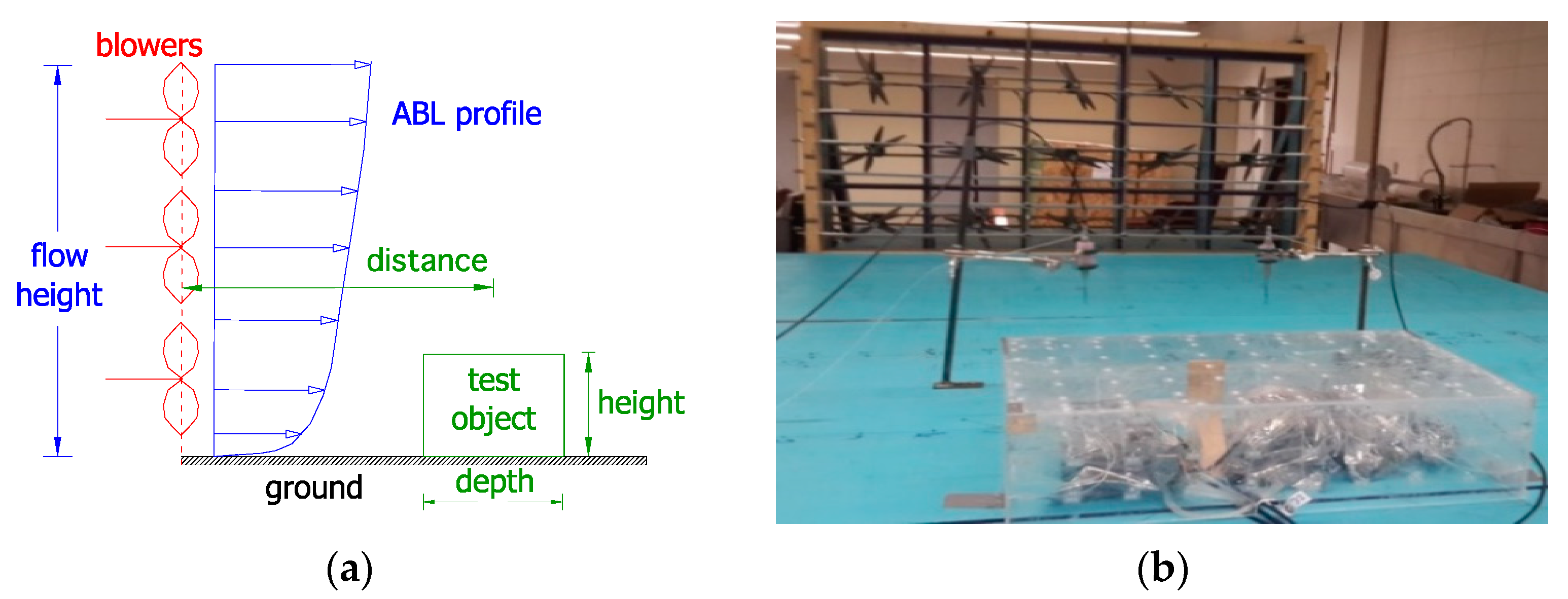
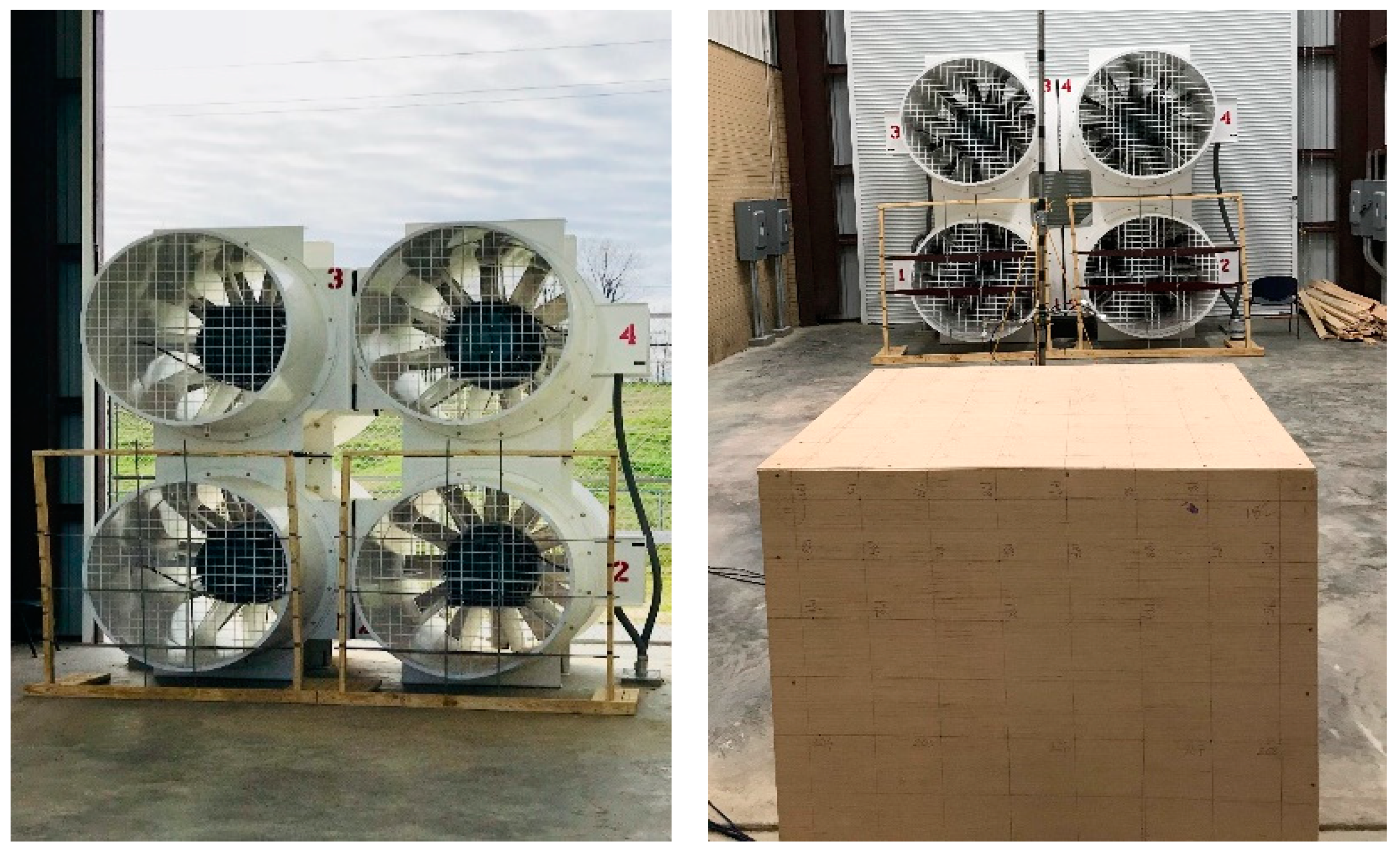
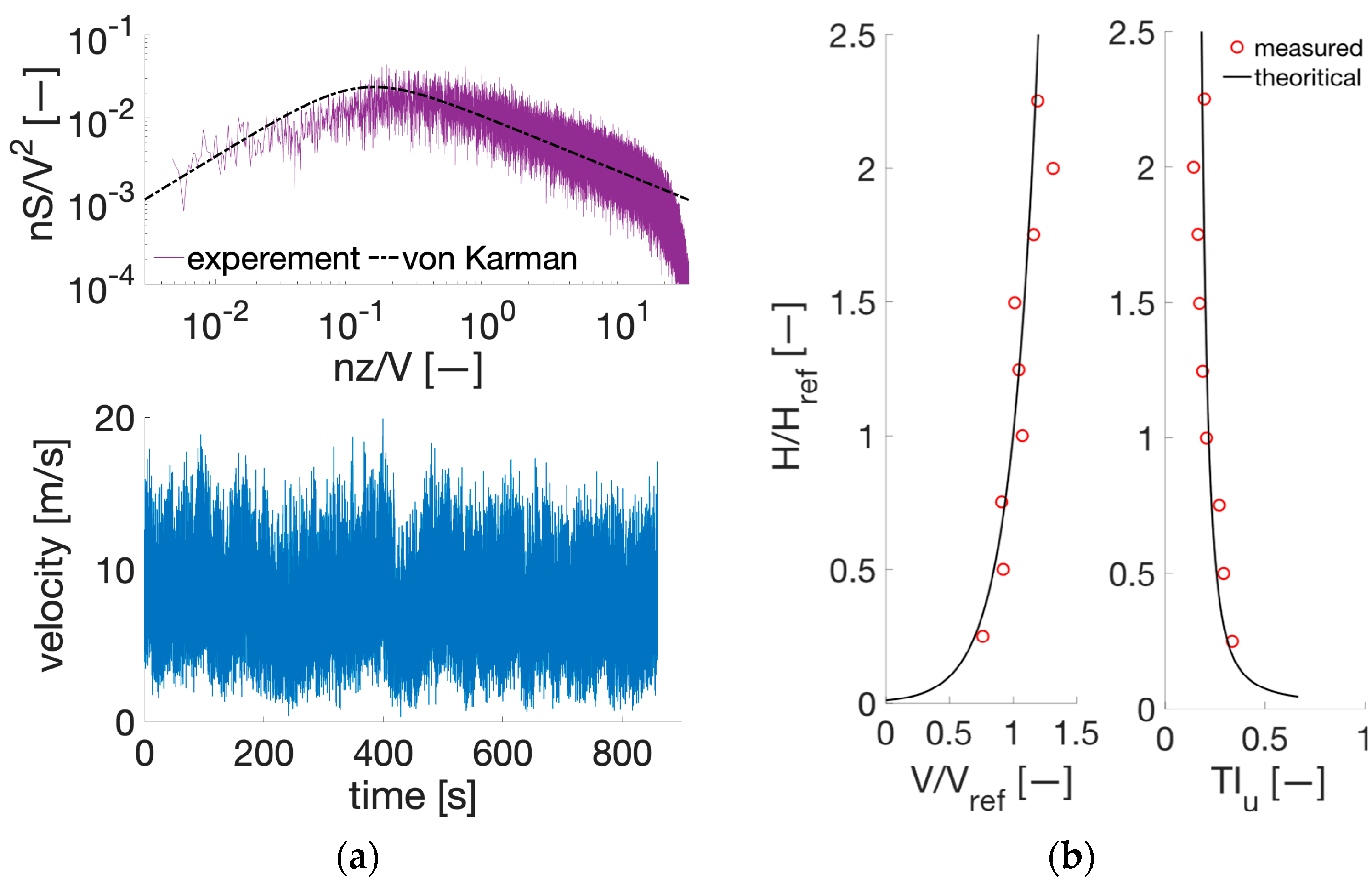





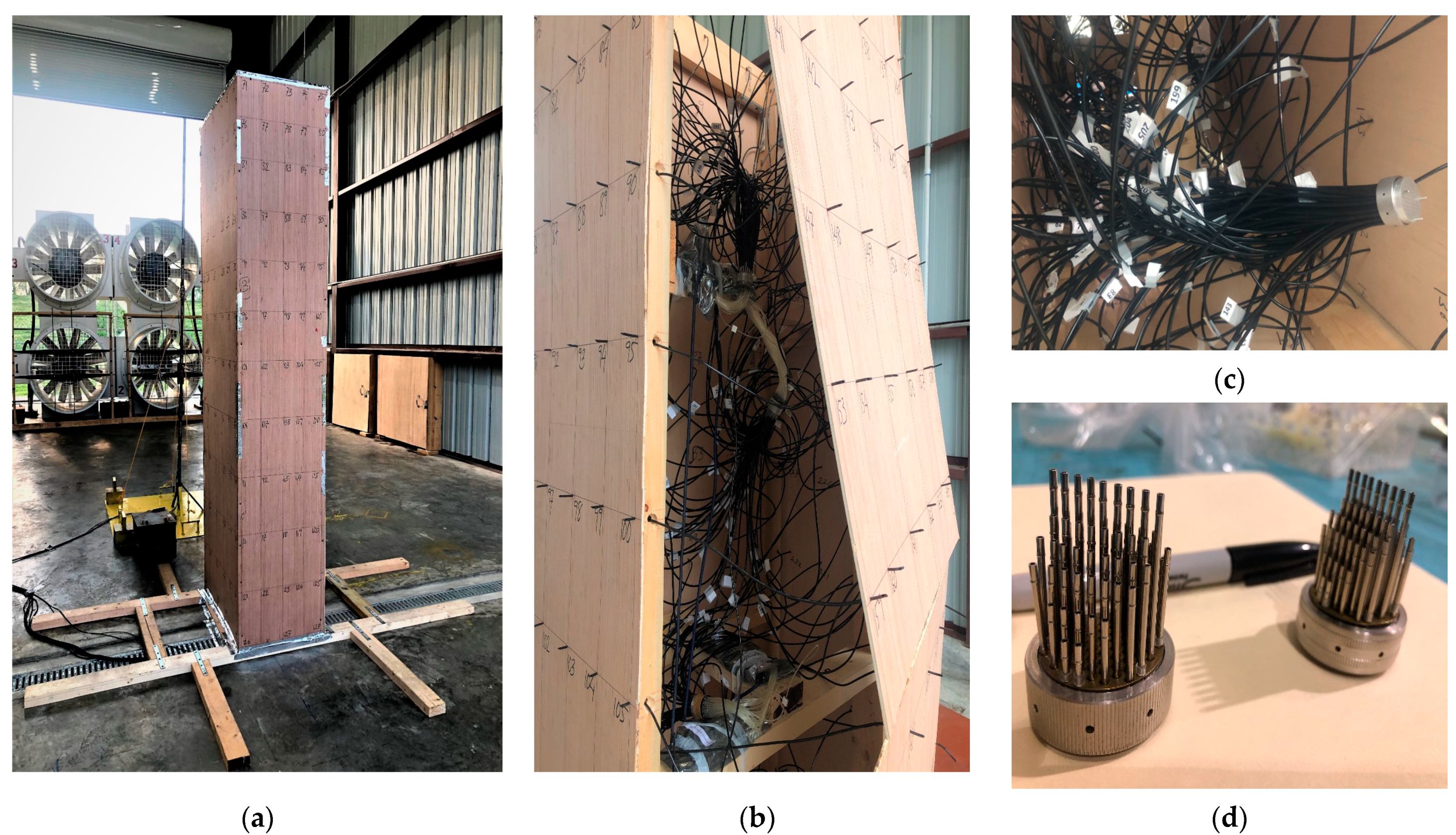

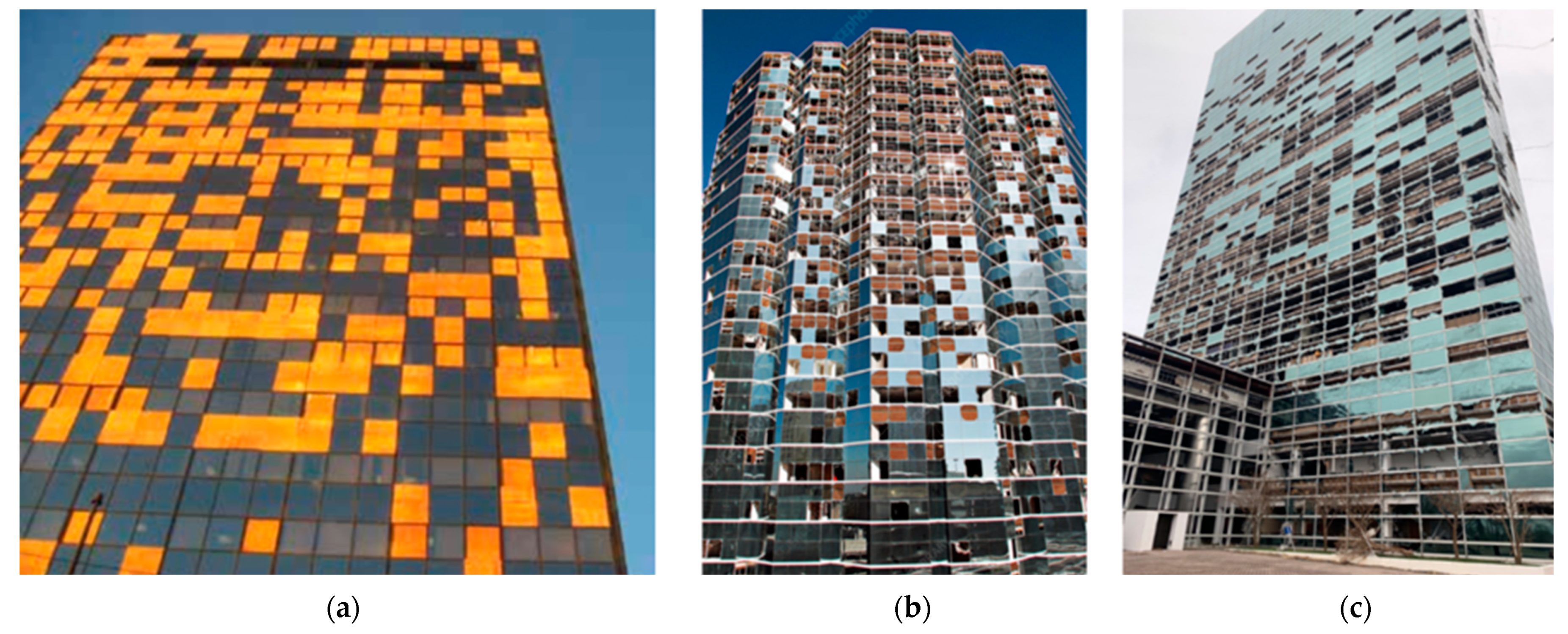
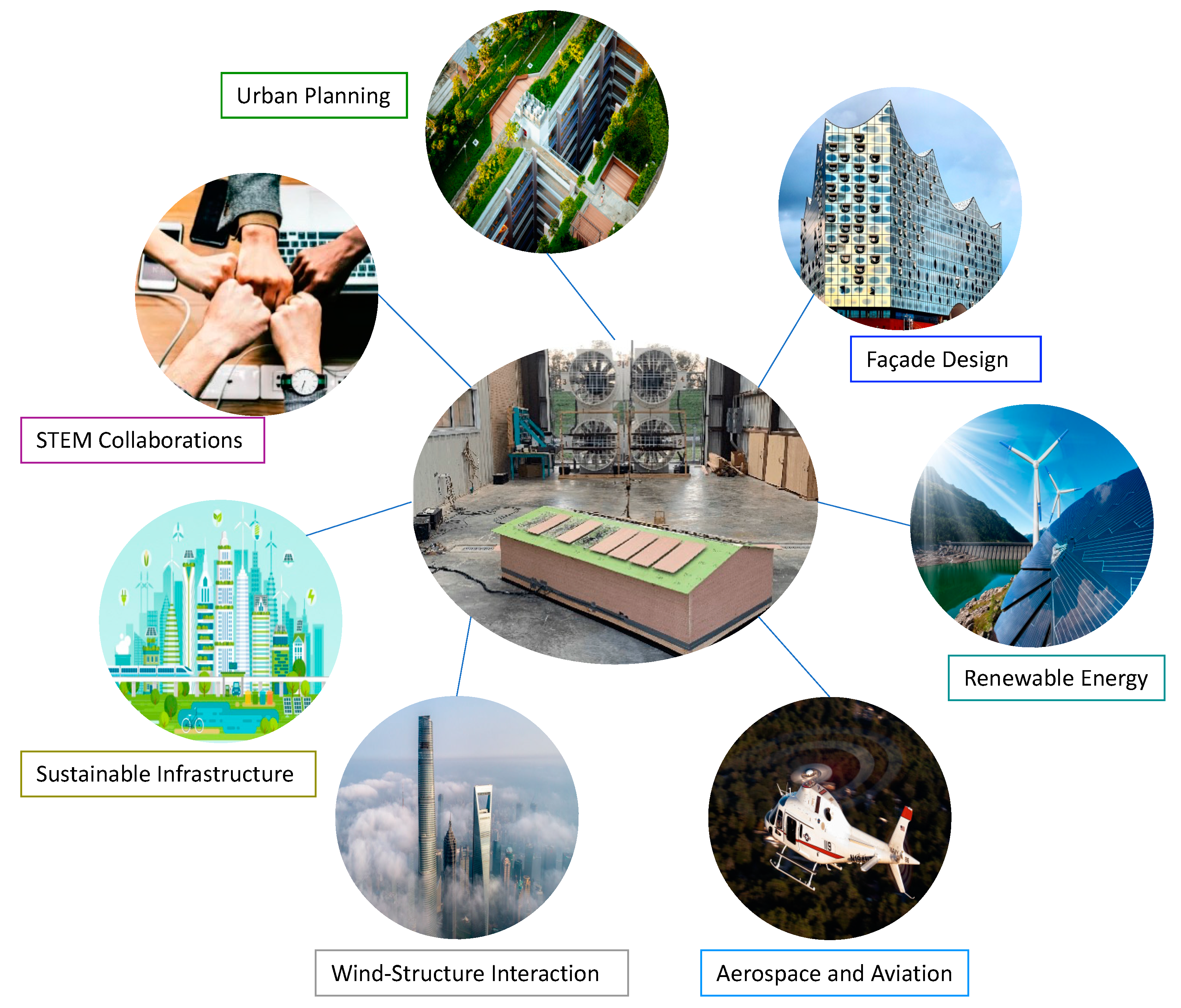
| Scale | 1:100 (TPU WT) | 1:26 (LSU OJ) | 1:13 (LSU OJ) |
| Reynolds number |
| Zone | Case 1 | Case 2 | Case 3 | Case 4 | ||||
|---|---|---|---|---|---|---|---|---|
| Cp | Angle | Cp | Angle | Cp | Angle | Cp | Angle | |
| 1W | −0.865 | 0 | −0.400 (54%) | 0 | −0.478 (45%) | 0 | −0.336 (61%) | 270 |
| 1L | −0.906 | 0 | −0.362 (60%) | 180 | −0.436 (52%) | 180 | −0.335 (63%) | 270 |
Disclaimer/Publisher’s Note: The statements, opinions and data contained in all publications are solely those of the individual author(s) and contributor(s) and not of MDPI and/or the editor(s). MDPI and/or the editor(s) disclaim responsibility for any injury to people or property resulting from any ideas, methods, instructions or products referred to in the content. |
© 2023 by the author. Licensee MDPI, Basel, Switzerland. This article is an open access article distributed under the terms and conditions of the Creative Commons Attribution (CC BY) license (https://creativecommons.org/licenses/by/4.0/).
Share and Cite
Aly, A.M. Breaking Boundaries in Wind Engineering: LSU WISE Open-Jet Facility Revolutionizes Solar Panel and Building Design. Appl. Sci. 2023, 13, 12546. https://doi.org/10.3390/app132312546
Aly AM. Breaking Boundaries in Wind Engineering: LSU WISE Open-Jet Facility Revolutionizes Solar Panel and Building Design. Applied Sciences. 2023; 13(23):12546. https://doi.org/10.3390/app132312546
Chicago/Turabian StyleAly, Aly Mousaad. 2023. "Breaking Boundaries in Wind Engineering: LSU WISE Open-Jet Facility Revolutionizes Solar Panel and Building Design" Applied Sciences 13, no. 23: 12546. https://doi.org/10.3390/app132312546
APA StyleAly, A. M. (2023). Breaking Boundaries in Wind Engineering: LSU WISE Open-Jet Facility Revolutionizes Solar Panel and Building Design. Applied Sciences, 13(23), 12546. https://doi.org/10.3390/app132312546






